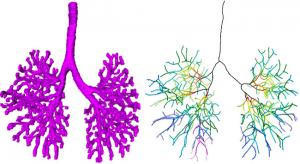先天異常解析センター、ゲッチンゲン大学解剖学研究室との共同研究で、今年で3年目です。
今年度は9月の2-4週にのべ8名、本研究室からはM1の鈴木さん、西谷さんが参加しました。

130症例近くのガラス標本の撮像が終了しました。今後、成果をWeb等で公表する予定です。
|
||||
|
共同研究者の勝部先生の論文の図がprenatal Diagの表紙に採用されました。
⑭ Katsube M, Yamada S, Miyazaki R, Yamaguchi Y, Makishima H, Takakuwa T, Yamamoto A, Fujii Y, Morimoto N, Ito T, Imai H, Suzuki S, Quantitation of nasal development in the early prenatal period using geometric morphometrics and MRI: A new insight into the critical period of Binder phenotype. Prenatal Diag 37: 907–915, 2017, DOI: 10.1002/pd.5106.2017 AbstractObjectivesDisturbance of the development of the nasal septum in the early prenatal period causes congenital facial anomalies characterized by a flat nose and defects of the anterior nasal spine (ANS), such as Binder phenotype. The present research aimed to assess the development of the nasal septum and the ANS with growth in the early prenatal period. MethodsMagnetic resonance images were obtained from 56 specimens. Mid-sagittal images were analyzed by using geometric morphometrics for the development of the nasal septum, and angle analysis was performed for the development of the ANS. Additionally, we calculated and visualized the ontogenetic allometry of the nasal septum. ResultsOur results showed that the nasal septum changed shape in the anteroposterior direction in smaller specimens, while it maintained an almost isometric shape in larger specimens. Furthermore, mathematical evidence revealed that the maturation periods of the shapes of the ANS and the nasal septum were around 12 and 14 weeks of gestation, respectively. ConclusionThe anteroposterior development of the nasal septum is specific until 14 weeks of gestation, and it is important for nasal protrusion and the development of the ANS. Therefore, the disturbance of such development could induce low nasal deformity, including Binder phenotype. 57回日本先天異常学会学術集会・第6回日本DOHaD学会 合同学術集会 ( 2017.8.26-28, 東京, 新宿)で発表しました。
学生部門で高石くんが日本病理学会総会最優秀賞を受賞しました。 英語口演
□ ヒト気管支発生の 3 次元的解析
Three-dimensional analysis of the bronchial branching in human embryonic stages
高桑徹也、村中太河、山田重人 他(急遽英語で発表しました!!)
ポスター
□ EFICを用いた膝関節の形態形成の解析(学生ポスター)日本病理学会総会最優秀賞受賞!!
Three-dimensional reconstruction of rat knee joint using episcopic fluorescence image capture
高石亮太、Xiangkai Zhang、青山朋樹、山田重人、高桑徹也
□ ヒト胚子期における脳形態形成の解析
Morphology and morphometry of the human embryonic brain: A three-dimensional analysis 白石直樹、片山愛里、中島崇、山田重人、上部千賀子、巨瀬勝美、高桑徹也 新学術領域研究「多元計算解剖学」第3回 国際シンポジウム(2017.3.8-9,奈良県文化会館) で発表しました。 A01-KB004 Three-dimensional Analysis of the Bronchial Branching in Human Embryonic Stages – Progress Overview FY2016 日本語
 奥村さんの卒業研究がPLoS Oneに受諾されました。 ヒトの骨格形成は、保存しやすく、レントゲンでの解析が可能な骨化中、骨化後の解析がほとんどで、軟骨形成期の解析はほとんどされていません。今回、骨盤の軟骨形成期に着目し解析を進めました。
28. Okumura M, Ishikawa A, Aoyama T, Yamada S, Uwabe C, Imai H, Matsuda T, Yoneyama A, Takeda T, Takakuwa T, Cartilage Formation in the Pelvic Skeleton during the Embryonic and Early-Fetal Period, PLoS One 12(4): e0173852. https://doi.org/10.1371/journal. pone.0173852 [Open Access] AbstractThe pelvic skeleton is formed via endochondral ossification. However, it is not known how the normal cartilage is formed before ossification occurs. Furthermore, the overall timeline of cartilage formation and the morphology of the cartilage in the pelvis are unclear. In this study, cartilage formation in the pelvic skeletons of 25 human fetuses (crown-rump length [CRL] = 11.9–75.0 mm) was observed using phase-contrast computed tomography and 7T magnetic resonance imaging. The chondrification center of the ilium, ischium, and pubis first appeared simultaneously at Carnegie stage (CS) 18, was located around the acetabulum, and grew radially in the later stage. The iliac crest formed at CS20 while the iliac body’s central part remained chondrified. The iliac body formed a discoid at CS22. The growth rate was greater in the ilium than in the sacrum-coccyx, pubis, and ischium. Connection and articulation formed in a limited period, while the sacroiliac joint formed at CS21. The articulation of the pubic symphysis, connection of the articular column in the sacrum, and Y-shape connection of the three parts of the hip bones to the acetabulum were observed at CS23; the connection of the ischium and pubic ramus was observed at the early-fetal stage. Furthermore, the degree of connection at the center of the sacrum varied among samples. Most of the pelvimetry data showed a high correlation with CRL. The transverse and antero-posterior lengths of the pelvic inlet of the lesser pelvis varied among samples (R2 = 0.11). The subpubic angle also varied (65–90°) and was not correlated with CRL (R2 = 0.22). Moreover, cartilaginous structure formation appeared to influence bone structure. This study provides valuable information regarding the morphogenesis of the pelvic structure. 2016年度の修士学位論文発表会が行われました(2/8-2/9). ヒト胚子期における気管支分岐形成の三次元的解析  村中くんが下記の内容で発表しました。持参したコンピュータが会場のプロジェクターと繋がらず、コンピュータを急遽替えたため、用意したMovieが動かなかったり、改行がずれたりしましたが、内容には多くの方が興味を持っていただけました。良い発表であったと思います。 【背景】呼吸器の発生はCarnegie Stage(CS)12頃に始まり、生後数年まで発達が続く。器官形成期における組織学的な研究は多く報告されているが3次元的な検討は行われていない。 【対象と方法】京都大学大学院医学研究科附属先天異常標本解析センター所有のCS13~CS22のヒト胚子から得られた立体情報計36個体を対象とした。用いた個体はいずれも明らかな外表奇形、呼吸器の異常を伴っていない。1) 位相CT画像とEFICの画像情報をもとに気管支の立体像を作成しCSごとのヒト気管支の形成過程を観察した。気管支樹を作成し2) Metzgerらが提唱したマウス気管支の分岐patternに基づいた定性的検討、3) 気管支単位の角度計測をもとに数理的な検討、を行った。 【結果】1)形成過程の観察:CS13で左右の一次気管支芽が形成され、CS16で二次気管支芽が形成された。CS20ですべての区域気管支が観察された。一次気管支芽はCS13~CS16までは気管に対して背側方向に伸長し、CS17以降では腹側に伸長した。CSが進むにつれて気管支樹の最大分岐数が増加し、CS22で最大15分岐の気管支が観察された。各葉別の最大分岐数は、葉気管支を基準(第一分岐)とすると、多い順に右下葉、左下葉、左上葉、右上葉、右中葉だった。 2)マウス気管支の分岐patternに基づいたヒト気管支の定性的解析:k番目の分岐がDomain branchingの場合、k+1番目の分岐はDomain branching、Planar bifurcation、Orthogonal bifurcationのいずれも観察されたが、分岐patternがPlanar bifurcation、Orthogonal bifurcationである分岐は最も末梢の分岐のみに観察された。Orthogonal bifurcationの分岐において回転角が約90°の分岐と約45°の分岐が見られ、約90°の回転角の分岐の方が多いものの、約45°の回転角の分岐も一定数見られた。 3)気管支の数理的解析:Symmetric patternは主に末梢側で見られ、Asymmetric patternは中枢側と末梢側のどちらにも見られ、明瞭な分布の差はなかった。Symmetric patternはMetzgerらのPlanar bifurcationとOrthogonal bifurcationと類似点が見られた。Asymmetric patternはMetzgerらが定義したpatternに類似するものはなかった。 【結論】ヒト胚子期のCSごとの気管支の発生過程を形態学的、定性的、定量的に明らかにした。気管支の正常発生を知ることで異常個体の解析に応用できる可能性がある。 44. Fujii S, Muranaka T, Matsubayash J, Yamada S, Yoneyama A, Takakuwa T. The bronchial tree of the human embryo: an analysis of variations in the bronchial segments. J Anat 2020, 237, 311-322. doi: 10.1111/joa.13199. 48. Fujii S, Muranaka T, Matsubayashi J, Yamada S, Yoneyama A, Takakuwa T. Bronchial tree of the human embryo: categorization of the branching mode as monopodial and dipodial, PLoS One 16; e0245558, 2021, https://doi.org/10.1371/journal.pone.0245558 |
||||